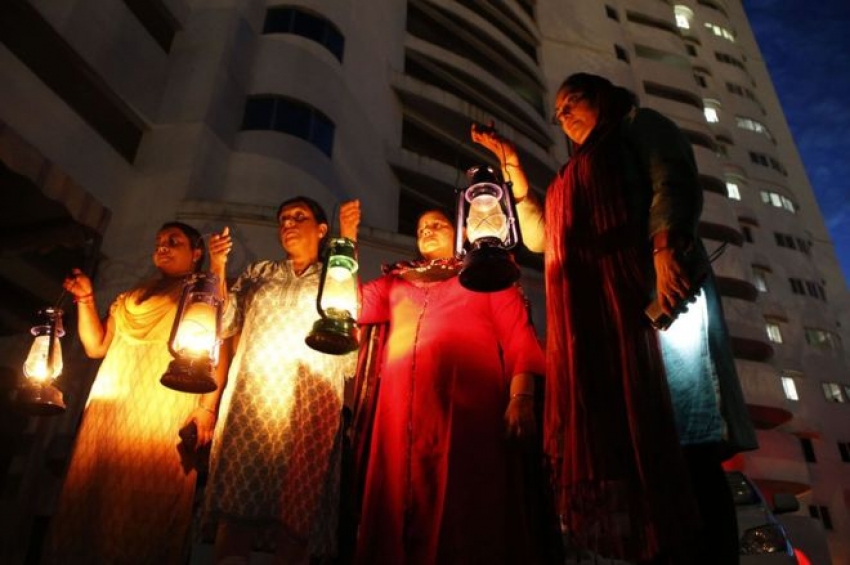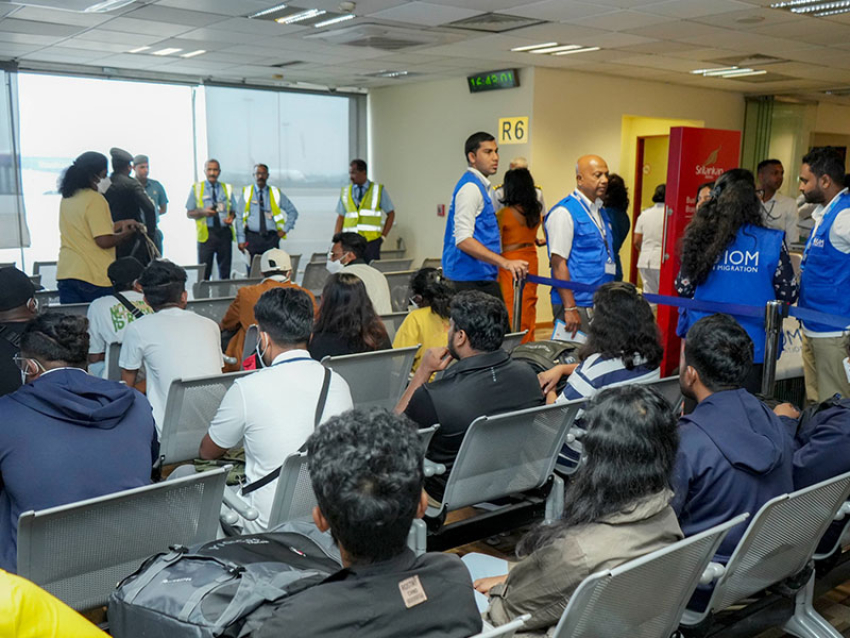Authorities in southern India have demolished two luxury lakeside apartment complexes that were built in violation of environmental rules. Residents of the high-rises in the state of Kerala watched as their homes and investments imploded in seconds. The Supreme Court ordered the demolition last year, after a committee found that they were built in breach of rules protecting coastal areas. Two more skyscrapers were set to be razed on Sunday. In total, some 343 flats - home to about 2,000 people - were expected to be destroyed over the weekend in what has been described as one of India's largest demolition drives involving residential buildings. The H2O Holy Faith complex, containing 90 flats, was the first to be brought down on Saturday. It took just seconds for the 19-floor building to be destroyed in a controlled implosion.
The families waiting for their homes to be blown up Resident Shamshudeen Karunagapally said his wife and children could not watch the buildings go down as it was "too painful for them to see their dreams shatter before their eyes". "We are suffering without any fault," he told AFP news agency.
How did we get here?
The Kerala Coastal Zone Management Authority (KCZMA), which was created to prevent degradation of coastal and marine areas, says permission for the buildings to be constructed was given by local officials without its approval.The KCZMA said the location of the apartment complexes, in the municipality of Maradu, was a critically vulnerable area where no new construction was allowed.
After they were built, bankers, executives and affluent retirees were among those who bought up the luxury apartments. One bank executive told the BBC last year that he had spent what would now amount to $70,000 (£55,000) to purchase a 2,140 sq ft (198 sq m) flat in Alfa Serene in 2006.One of his neighbours sold his apartment last year for $176,000, he said. But in May, the Supreme Court ruled in favour of KCZMA and ordered the demolition of the buildings, although officials had never sought it. The court said builders were in breach of construction rules and called illegal construction in the area a "colossal loss" to the environment. It also referred to the devastating floods in Kerala in 2018 and said they were the result of "the entire environment being degraded and coastal zones being illegally occupied".
Following the top court ruling, some residents initially refused to leave. But officials cut water and electricity supplies to the buildings, leaving them with no choice but to go.The state government has been ordered to pay "interim compensation" of about $35,000 (£27,000) to affected residents, according to local media reports.
Skyscrapers have pierced the air for over 150 years, but occasionally these huge structures are no longer wanted, and have to be replaced. How do you set about such a job?They soar high above the world's cities, glittering symbols of mankind's power and wealth.But sometimes what goes up has to come down.When they are damaged, or fall out of favour, or outlive their original purpose, very tall buildings occasionally have to be flattened.But doing so is an extremely tricky task - and as skyscrapers rise higher and higher each year, the task of bringing them back down becomes increasingly complicated.Almost everyone has seen spectacular footage of towers being blown up with explosives.The knack of getting an edifice to collapse on to itself - known as implosion - is a highly skilled specialism.In the kind of densely-built areas where high buildings tend to proliferate, however, such demolitions are not generally remitted. As a result, engineers have had to come up with increasingly innovative ways of felling tall structures. Tallest demolished buildings
Singer Building, New York, 1968 - 614 ft (187 m)
City Investing Building, New York, 1968 - 487 ft (148 m)
Morrison Hotel, Chicago, 1965 - 526 ft (160 m)
"There's an art and a science to it," says Michael Taylor, executive director of the National Demolition Association, which represents US contractors and specialists in the industry. One of the more elaborate techniques, pioneered in 2008 by Japanese construction firm Kajima, involves knocking out the bottom floor and lowering the structures above it on computer-controlled hydraulic jacks. Stop-motion footage of the system makes it look as though a 20-storey building is sinking into the ground.
Developers may have to think even more creatively in the future. The world's tallest skyscraper, the Burj Khalifa in Dubai, is at 2,722ft (829m) vastly taller than anything that has been levelled before.The highest-reaching tower to be peacefully demolished was the 47-storey, 612ft (187m) Singer building in New York, which was taken down manually between 1967 and 1968.How exactly someone would go about dismantling the new breed of "mega-tall" structures like the Burj Khalifa is unclear.
The 15-floor P&O building in the City of London was demolished from the bottom up"The short answer is that we don't know," says Antony Wood, executive director of the Council on Tall Buildings and Urban Habitat.
However, demolition experts have extensive experience of taking apart edifices of an earlier vintage. At present, buildings in closely-packed downtown urban districts tend to be dismantled manually.There are a number of ways to do it.One method involves the team of engineers dismantling the building top to bottom, floor by floor. However, fire or structural damage might render this unsafe.Instead, the demolition crew could use a high-reach mechanical excavator with a long arm to pull down the upper storeys. After the New Zealand earthquakes of 2010 and 2011, a 65m (213 ft) device of this kind nicknamed "Twinkle Toes" was imported from the UK to pull down damaged high-rises in Christchurch.Alternatively, if the exterior wall is a "curtain" - that is, it is not part of the structure, but forms an outer covering, typically made of glass - it can be pulled inside the structure using a crane, once the interior has been gutted.In some cities, however, it may still be permitted to blow the building up.
The term implosion is something of a misnomer. In fact, the technique involves strategically placing explosive charges to remove a building's support structure so that it collapses on itself, causing as little damage to its surroundings as possible.The results are quick - typically, an implosion takes eight seconds - and spectacular.Image captionThe Three Gorges Hotel and a passenger terminal are imploded in Chongqing, Chinaotage of such operations - such as that to take down the 29-floor JL Hudson epartment store in Detroit, Michigan, the largest building ever to be imploded - make compelling viewing.However, carrying out such a demolition involves painstaking preparation. It can take up to six months to survey the structure and prepare it for the blast by removing non-load bearing walls, weakening support structures and fitting the charges. Clearing up debris afterwards can take up to two months.Also, the results can be disastrous if something goes wrong. In 1997 nine people were injured and a 12-year-old girl was killed by flying masonry during the demolition of the Royal Canberra Hospital in Australia.
When carried out correctly, these demolitions can be achieved with a high degree of accuracy. According to Taylor, the 1991 implosion of Orlando City Hall - which featured in the film Lethal Weapon 3 - was achieved without breaking a single window on an adjacent building 4ft away.The symbolism of blowing something up in front of large crowds of onlookers has regularly been harnessed by politicians and developers - particularly in the case of unpopular high-rise public housing projects, Taylor believes."Let's not forget the political effect of it," he says."They were saying to the country, 'This was a failed public strategy. We are changing.'"Partly for this reason, implosions tend to occur in areas of urban deprivation.
However, remarkably few skyscrapers in places like Manhattan and Chicago - where the first such multi-storey structures sprung up - have been dismantled, despite them having been with us since the late 19th Century.The Windsor Tower in Madrid, Spain, demolished after a fire in 2005According to Carol Willis, curator of the Skyscraper Museum in New York, there is a good economic reason for this.In the early days of high-rise construction there were few planning regulations, she says. In her city this changed in 1916 and again in 1961 with the introduction of limits on floor areas.So anything built on the site of an early skyscraper which had been demolished would be smaller and thus less valuable."So you don't take skyscrapers down," she says. "You refit or repurpose them."Some of these retro-fittings have made quite a difference.In 2007, 10 years after it initially went up, engineers began adding an additional 24 levels to the 33-storey Blue Cross Blue Shield Tower in Chicago.France's tallest building, the Tour First in Paris, had an additional 66m (216ft) added to its height in a refit completed in 2011.The problem is that no-one really knows what the life expectancy of a tall building is, says Wood, whose organisation has launched a study into the subject.But his personal belief is that there is no reason why skyscrapers cannot be re-fitted indefinitely."They need to be designed to be never taken down, such that their life cycle is as close to forever as you can get," he says."No-one's talking about when the pyramids are going to come down."If that's possible, skyscrapers would truly defy gravity. What goes up doesn't necessarily have to come down.
Indian skyscrapers to be brought down in controlled implosions
By Ashraf Padanna
BBC News
16 October 2019
Share this with Facebook Share this with Messenger Share this with Twitter Share this with Email Share
Image copyrightSIVARAM V
Image caption
Home owners have protested against the Supreme Court's demolition order
For more than a decade, thousands of people have made their homes in four skyscrapers that sit along an idyllic lakefront in southern India. But now they are set to watch their homes - and their investments - implode before their eyes, following a battle over the environment which went all the way to the Supreme Court.
In 2006, PP Joseph, a bank executive, spent what would now amount to $70,000 (£55,000) to purchase a 2,140 sq ft (198 sq m) flat in Alfa Serene. The 16-storey private apartment building overlooked the backwaters of the Vembanad lake, the largest in the state of Kerala, in the city of Cochin.
Thirteen years later, Mr Joseph finds himself out of a home and unsure of whether he can recoup his investment.
Alfa Serene and three other buildings - which together house 343 flats and some 2,000 people - will be brought down in implosions later this month. The luxury apartments once housed bankers, executives, film actors and directors, affluent retirees, expatriates and even a media advisor to a senior politician.
Now, they stand empty.
"When I bought my flat, the builders said there was no pending litigation, and this was included in my sale deed," Mr Joseph says. "They were cheating us."
'Where can we go?'
India's Supreme Court ordered the demolition last May, after an official committee found that the buildings were constructed in breach of environmental rules protecting coastal areas.
Faced with the prospect of homelessness, some residents initially refused to leave.
"Whatever happens, we are not going to move out. They will have to tread over our bodies," one resident, named only as Joyson, told Gulf News.
But officials cut water and electricity supply to the buildings - then still home to dozens of children and almost 150 pensioners. The residents had no choice but to go.
The residents had also fought through the courts - but their pleas went unheeded: the Kerala state government told the court last month that it would carry out the implosion in 90 days, leaving home owners disappointed, frustrated and scared for their futures.
"I bought this flat to stay with my elderly mother," widow Maya Prem Mohan, 60, told NDTV. "We have not much savings left. We have medical needs.
"Where can we go at this age? Can we afford another house?"
Image copyrightSIVARAM V
Image caption
The apartment blocks are in breach of environmental rules
The court has said the owners should be compensated to the tune of $35,000 (£28,000). However, the money is supposed to be recouped from the company which built the four tower blocks - and they are nowhere to be found.
The BBC has tried contacting the builders - Paul Raj and Sini Joseph - but they have been unreachable.
Police told the BBC that they had registered a case of cheating against them and have searched their offices. The court has frozen their bank accounts and attached properties.
But for homeowners, the missing builders are just one of a list of problems. The compensation itself is too little, they say, and there are others at fault.
"Just days before the demolition order was issued, my neighbour sold his apartment for $176,000," Mr Joseph says. "Sale of flats continued as buyers were not expecting the Supreme Court to leave us homeless overnight."
Karunagappally, a lawyer and homeowner, said that because many of the owners live and work in the Middle East, the situation is even more unfair. It is difficult for them to pursue any legal action in India.
"The [officials] that issued permits to the builders are primarily responsible for our plight," he added.
Image copyrightSIVARAM V
Image caption
The residents battled through the courts to defend their homes
The problem appears to come down to two different planning authorities, with different ideas about the land.
The Maradu village council granted building permits between 1995 and 2006. However, the Kerala Coastal Zone Management Authority (KCZMA) opposed the permits.
KCZMA, created in 1991 to prevent degradation of the coastal and marine areas, alleges permission was given without its mandatory approval.
Construction is regulated according to the classification of the zone and Maradu, according to KCZMA, is classed as a critically vulnerable area where no new construction is allowed.
But local officials allowed construction, defining Maradu as an urban area in a coastal belt where residential buildings are allowed.
Following the KCZMA's protest, the village council tried to stop construction. But the builders petitioned the Kerala high court, which, in 2007, allowed construction to continue. In a 2016 ruling, it blamed the officials for granting building permits.
Is this the world's most eco-friendly school?
Why the Kerala floods proved so deadly
Why India's air looks different from space
India's unique way to beat air pollution
The KCZMA then appealed to the Supreme Court. The top court not only ruled in favour of KCZMA, but also ordered the demolition, although officials had never sought it.
In its ruling, the court referred to the devastating floods in Kerala in 2018 and said they were the result of "the entire environment being degraded and coastal zones being illegally occupied".
Environmental groups welcomed the judgement, hoping it would serve as a deterrent.
The court will hear the case again on 23 October to monitor the progress of the demolition.
However, now authorities in Maradu are on the hunt for demolition experts who can bring down the four apartment blocks swiftly and safely. It's expected to cost the municipality around $140,000.
The buildings are located in a sensitive coastal zone
"We have received 15 proposals [from demolition experts] and are in talks with one of them," says Nadeera Mahboob, chairperson of the municipal council. "They promise to safely pull down these structures without any damage. We are seeking the best method to implode them."
The demolition could affect some 100 households in the neighbourhood, as well as water bodies, bridges and gas pipelines - a fact that concerns local officials.
The buildings will be handed over to a demolition contractor who specialises in swift controlled implosions. Residents living nearby will be alerted before the blast.
Ms Mahboob says removal of debris will be a long process, and the structures will be covered before the implosion to prevent the dust from spreading far.
"Our sympathy lies with the home owners. But you need to stop illegal construction on encroached land as a warning for others," she adds.




















